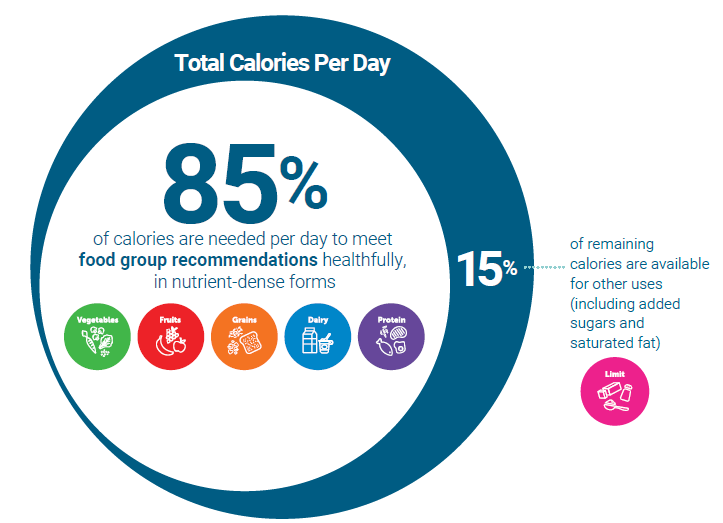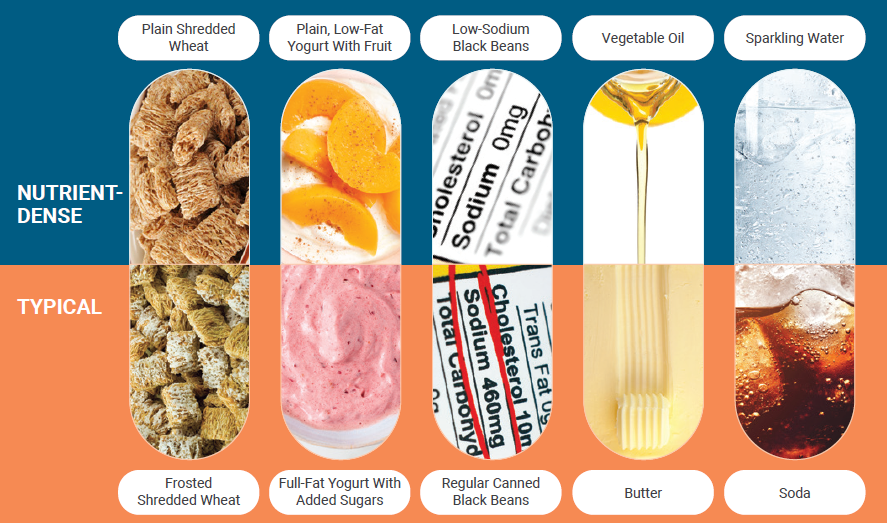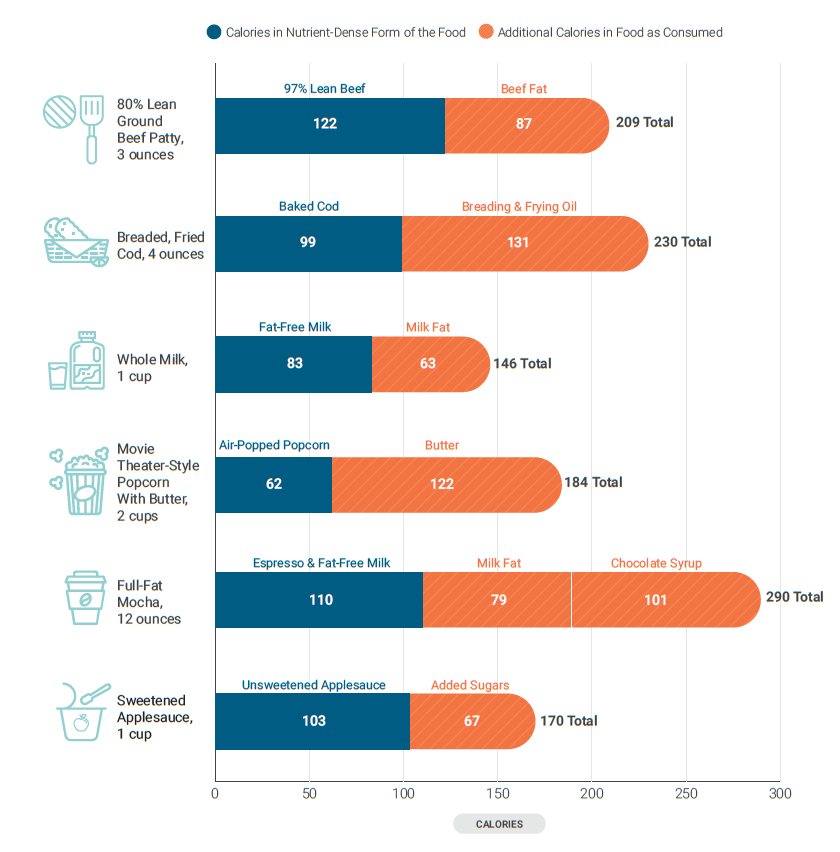2.2 Dietary Guidelines for Americans 2020-2025
The Dietary Guidelines for Americans are a set of general nutrition related lifestyle recommendations for healthy people to promote health and reduce risk of chronic disease. The Dietary Guidelines are reevaluated and updated every five years by the advisory committees of the US Department of Agriculture (USDA) and the US Department of Health and Human Services (HHS). The guidelines are continually revised to keep up with new scientific evidence-based conclusions on the importance of nutritional adequacy and physical activity to overall health. Researchers study what types of foods Americans eat and in what quantities. More information on this research and data collection can be found here. This research can be used to compare what nutrients we are consuming enough of and what nutrients we are likely to be deficient in. This information is used to create recommendations for types of foods to eat to help people be more in line with the DRI recommendations. The goal of the Dietary Guidelines is to provide informative guidelines that will help any interested person in obtaining optimal nutritional balance and health. The 2020 Dietary Guidelines were released in January 2021.
The theme of the 2020 Dietary Guidelines is “Make Every Bite Count.” This means to focus on consuming more nutrient dense foods and beverages; limit empty calorie foods higher in saturated fat, added sugar, and sodium; and stay within your calorie limits. This gives an individual many options to choose an eating pattern that works best for them based on their individual food preferences, lifestyle, and budget.
Nutrient dense foods are foods that are relatively high in nutrients compared to the number of calories they contain. Whole grains, lean meats, seafood, fruits, vegetables, legumes or beans, eggs, low-fat or fat-free dairy products, nuts, and seeds are all examples of nutrient dense foods. Nutrient dense foods are often less processed but canned beans, fruits, vegetables, and meats are still considered nutrient dense and can be a great way to get nutrients for many people because they are often less expensive, more shelf stable, or easier to prepare than unprocessed versions. Empty calorie foods are foods that are high in calories with relatively few vitamins and minerals. Processed foods high in added sugar, sodium, and solid fats are examples of empty calorie foods. Empty calorie foods have little to no nutritional value. Calorie dense foods are relatively high in calories per serving. Fat or lipid is the macronutrient with the most kcals per gram so foods high in fat are relatively calorie dense. Calorie dense foods aren’t necessarily bad for you – there are plenty of foods that are beneficial for your health that are also calorie dense. Some examples include olive oil, avocados, and nuts.
There are 4 key concepts in the 2020 Dietary Guidelines for Americans:
- Follow a healthy dietary pattern at every life stage.
- Customize and enjoy nutrient-dense food and beverage choices to reflect personal preferences, cultural traditions, and budgetary considerations.
- Focus on meeting food group needs with nutrient-dense foods and beverages, and stay within calorie limits.
- Limit foods and beverages higher in added sugars, saturated fat, and sodium, and limit alcoholic beverages.
These concepts are further broken down into chapters based on an individual’s age/sex/lifestage. You can find more information and access the full guidelines here.
When choosing foods, the dietary guidelines recommend that 85% of your diet should be composed of a variety of nutrient dense foods. What this looks like for an individual is likely to change across the lifespan – but developing flexible healthy habits when you are young will help you remain healthy as you age.
Figure 2.3 Recommended Percent of Calories from Nutrient Dense vs Non-nutrient Dense Foods

While you don’t need to give up all the empty calorie foods you enjoy, finding a way to make nutrient dense substitutions is one way that you can ensure that most of your diet is composed of nutrient dense foods. Figures 2.4 and 2.5 give you some examples of what small, realistic nutrient dense substitutions might look like.
Figure 2.4 Nutrient Density by Food or Beverage

In Figure 2.5 you can see that if you are eating a ground beef patty made with 80% lean ground beef you would be consuming a little over 200 kcals. However, the 87 calories from the beef fat are considered empty calories. The protein and micronutrients are mainly found in lean beef. Switching from 80% lean ground beef to 97% lean ground beef would be the more nutrient dense choice.
Figure 2.5 Examples of Calories in Food Choices That Are not Nutrient Dense and Calories in Nutrient-dense Forms of These Foods

Media Attributions
- Percent of Calories From Nutrient Dense vs Non Nutrient Dense Foods © USDA is licensed under a Public Domain license
- Nutrient Density by Food or Beverage © USDA is licensed under a Public Domain license
- Nutrient Density Calorie Comparison © USDA is licensed under a Public Domain license
